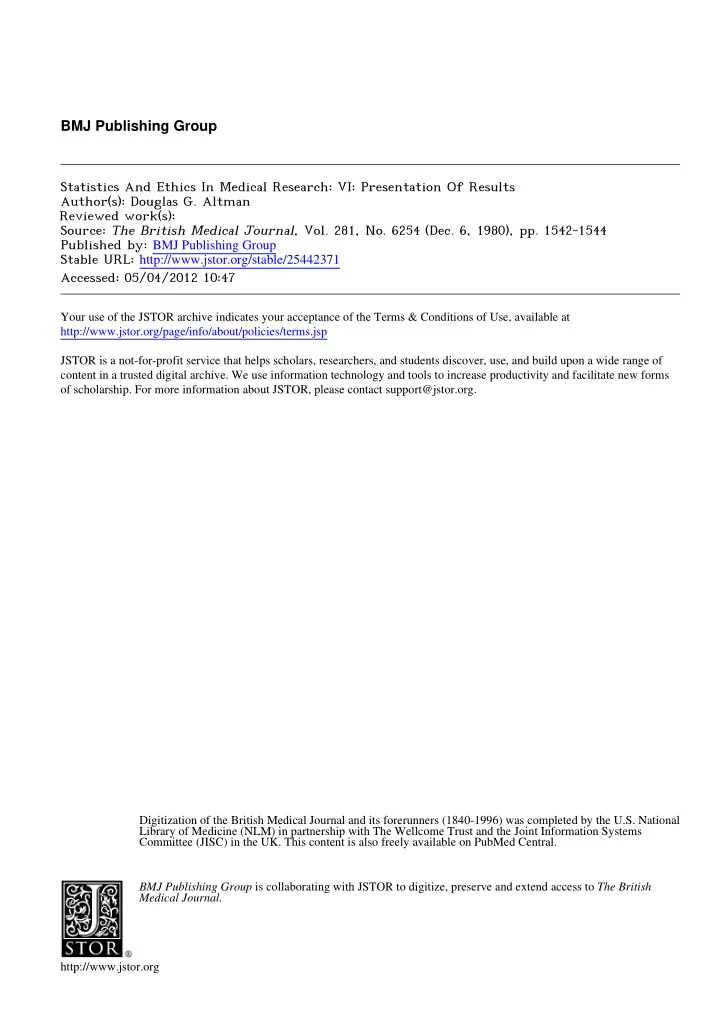

BMJ Publishing Group Statistics And Ethics In Medical Research: VI: Presentation Of Results Author(s): Douglas G. Altman Reviewed work(s): Source: The British Medical Journal, Vol. 281, No. 6254 (Dec. 6, 1980), pp. 1542-1544 Published by: BMJ Publishing Group Stable URL: http://www.jstor.org/stable/25442371 . Accessed: 05/04/2012 10:47 Your use of the JSTOR archive indicates your acceptance of the Terms & Conditions of Use, available at . http://www.jstor.org/page/info/about/policies/terms.jsp JSTOR is a not-for-profit service that helps scholars, researchers, and students discover, use, and build upon a wide range of content in a trusted digital archive. We use information technology and tools to increase productivity and facilitate new forms of scholarship. For more information about JSTOR, please contact support@jstor.org. Digitization of the British Medical Journal and its forerunners (1840-1996) was completed by the U.S. National Library of Medicine (NLM) in partnership with The Wellcome Trust and the Joint Information Systems Committee (JISC) in the UK. This content is also freely available on PubMed Central. BMJ Publishing Group is collaborating with JSTOR to digitize, preserve and extend access to The British Medical Journal. http://www.jstor.org
1542 BRITISH MEDICAL JOURNAL VOLUME 281 6 DECEMBER 1980 Medicine and Mathematics Statistics and ethics in medical research of results VI?Presentation DOUGLAS G ALTMAN A of statistical method is the clear Scatter and very important aspect diagrams regression numerical and of results. graphical presentation Although many For data sets scatter are simple diagrams tremendously textbooks and courses discuss visual methods statistical simple helpful. By showing all the data it is much easier for the reader such as histograms, bar and so on, are charts, pie charts, they to evaluate the that were carried out. It is essential, analyses as descriptive or introduced It usually investigative techniques. that coincident are indicated in some If however, points way. is uncommon to find discussion of how best to the present are different there within the data set sexes subgroups (different results of statistical This is since the analyses. surprising, perhaps) these may be indicated by means of different symbols. of the both the researcher and later results, interpretation by by extra at no This will information and will provide expense, help on readers of the paper, be the methods may critically dependent to show the of analysing the data (or otherwise) appropriateness to present used the results. as one or for each set, need be said here about the simple visual methods subgroup separately. Little are well The covered Huff.1 already mentioned?they by are more associated with rather graphs, however, problems important. 1000 1000 Anti-toxin Graphical presentation Z 800 1 In 1976 a Government of some publication2 gave examples successes in preventive medicine. One of these past examples in the 1930s of mass concerned the introduction immunisation 600 1(a) shows their presentation of against diphtheria. Figure Immunisation from 1871 to 1971. This childhood mortality from diphtheria to show that the introduction of immunisation resulted c 400 H appears in a rapid decline in mortality. In their however, figure, mortality on a logarithmic is plotted scale and shows proportional changes. the data are plotted on a linear scale,3 as in fig 1(b), the When 2 200 1 visual effect is quite different, as is the interpretation. From this we can see over the period o that in question from figure mortality had been dropping and this specific very quickly, diphtheria 1871 1951 measure was late in the This adopted relatively day. preventive is not to that the of was not fig (a) on a log scale2 (b) on a linear introduction immunisation 1?Childhood from diphtheria say mortality scale.3 but that the degree of its effectiveness that one effective, accepts on which the data are presented. depends considerably way to be appropriate For data it is unlikely to experimental the scale of one or both axes unless it has been transform scatter to many Unfortunately, people diagrams automatically to out the on transformed data. For necessary carry analysis the calculation of correlations and the fitting of regression suggest carried out on log data, if analysis has been it is lines, eveji though one or both of these methods may be invalid example, better to show a scatter with a log scale to or of no sees scatter a straight probably diagram interest. One often where diagrams demonstrate that the transformed data with the no comply line has been drawn the data but reference is made through to in the figure or in the text. appropriate assumptions. it, either the intention is Perhaps to the data have been show that but "properly analysed," like demonstrate the reverse. this presentations How should results of regression analyses be presented ? This on the context. For if the will depend partly example, analysis shows the between two is too weak to that variables relationship be of practical value, then there may be little point in quoting Division of Computing and Clinical Research Statistics, the equation of the line of best fit. If the equation is given then Centre, Middx HAI Harrow, 3UJ the standard error of the slope (and of the intercept if this is of DOUGLAS G ALTMAN, bsc, medical statistician of scientific (member and the number of observations are practical importance) staff) information. One other is necessary, how important quantity
Recommend
More recommend